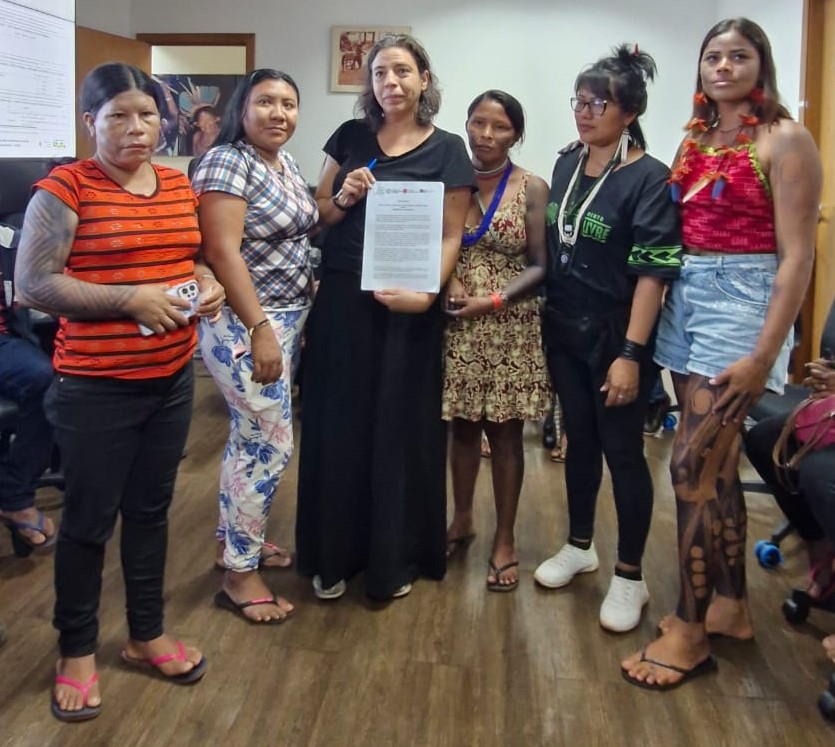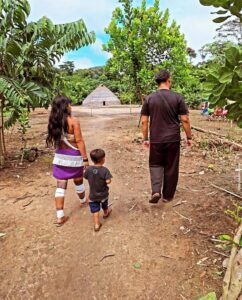Coiab, Opi, Isa and CCCA delivered a document suggesting changes to the territorial protection programme provided for in the Belo Monte licensing process
Parakanã, Arara and Juruna leaders took a series of suggestions for improving the protection of the indigenous territories of the Middle Xingu to the Territorial Protection Directorate of the National Foundation for Indigenous Peoples (FUNAI). This region has suffered brutal damage since the installation of the Belo Monte hydroelectric dam, in the municipalities of Altamira and Vitória do Xingu, in Pará state.
Operating with a licence that expired in 2021, the dam has brought enormous pressure on the region's nine indigenous lands, because of invaders who are breaking deforestation records every year. In order to contain this pressure, the Brazilian government and the dam consortium were supposed to install a Territorial Protection Plan for the Middle Xingu (PPTMX), with the construction of surveillance bases, environmental inspection actions and measures to demarcate, remove intruders and expand the territories. There have been serious delays in the implementation of this plan and in the process of renewing its Operational Licence (LO), currently underway, indigenous peoples are asking FUNAI for improvements and changes.
"Ranchers were removed but the support of our partners and FUNAI is fundamental so that inspections can be carried out to prevent new invasions. Half of our land has been deforested and now we need to reforest it," said Pinima Parakanã. The people are asking for new protection bases on their land to stop new invasions. Pipkotura Arara said that the elders of his people sometimes get lost when they go hunting, because loggers have felled so many trees that it makes it difficult for them to find their way around the forest. Motibi Arara called for indigenous people to be hired to work in the protection bases, as they know their territories more than anyone else.
Ya Juruna, from the Paquiçamba Indigenous Land, reported that the diversion of 70 per cent of the Xingu's water to feed the Belo Monte turbines has caused the extinction of fish and trees in the Volta Grande region and now the territories are now constantly invaded mainly by illegal and predatory tourism.
"Since 3 March 2023, in a meeting with the Ministry of Indigenous Peoples, Funai and Sesai, Coiab has made itself available to help rebuild the Brazilian state's indigenous policies," said Luiz Fernandes, Coiab's coordinator for isolated and recently contacted peoples, when presenting the document. Carolina Reis, from the Center for Climate Crisis Analysis (CCCA), emphasised the importance of expanding the existing bases so that they can serve as support for larger teams that can carry out periodic inspections in the territories.
Leonardo Halszuk, from the Socio-Environmental Institute (ISA), explained the urgency of moving forward with the removal if intruders from the Cachoeira Seca Indigenous Land, home to a people of recent contact and which is currently one of the most invaded and deforested in the region. Helena Palmquist, from Opi, remembered that the creation of an ecological corridor in the Volta Grande do Xingu region, where the Paquiçamba, Arara da Volta Grande, Trincheira Bacajá and Ituna Itatá lands are located, a condition of the dam project, has yet to be implemented. The use of the corridor would be restricted due to the presence of isolated indigenous groups.
The situation is set out in a technical note drawn up by the Coordination of Indigenous Organisations of the Brazilian Amazon (Coiab), the Observatory for the Human Rights of Isolated and Recently Contacted Indigenous Peoples (Opi), the ISA and the CCCA. The document was handed to Funai's director of territorial protection, Janete Carvalho, by five indigenous women leaders - Wenatoa Parakanã, Ya Juruna, Varin Marubo, Tipkotura Arara and Adoum Arara.
Janete Carvalho thanked them for the document and assured them that the suggestions would be taken into account in the renewal of the Territorial Protection Plan. She also announced that she will work towards the creation of an ecological corridor in the Volta Grande do Xingu area.
According to the document, the delays and inconsistencies in implementing the plan have caused serious problems in the indigenous lands of Cachoeira Seca (Arara people), Apyterewa (Parakanã people), Paquiçamba (Juruna people), Trincheira Bacajá (Xikrin people), Ituna Itatá (isolated peoples), Arara (Arara and Kuruaya peoples), Koatinemo (Assurini people), Araweté (Araweté people) and Xipaya (Xipaya people). The technical note reports that deadlines for the construction and operation of the so-called Territorial Protection Units (UPTs), which would serve as support bases for environmental inspections, have not been met. Some of these planned units have yet to be delivered and are undergoing adjustments.
One of the examples cited is that dam consortium Norte Energia's contract to provide a helicopter for Ibama's actions in Altamira ended in February and has still not been renewed. As a result, the agency's actions in the region have been weakened, which could lead to new invasions in territories that are already vulnerable. The note proposes 12 measures to be incorporated by FUNAI in the reworking of the plan, such as the implementation of a protocol between IBAMA and FUNAI, specific action plans for each land and greater agility in the demarcation and expansion of indigenous lands and the removal of invaders. Among the lands affected by Belo Monte, in the first year of the Lula government intruders were removed from the Apyterewa and Trincheira Bacajá territories and both intruders and illegal cattle were removed from Ituna Itatá.




